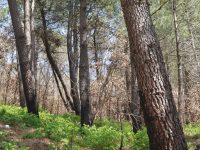The environmental factors that control the formation and evolution over time of soil coverings are several.
Soils are natural bodies that cover rocks and sediments like a continuum in space. The soil beneath our feet is not a chaotic mixture of organic and mineral substances, but has a specific interior architecture. In fact, it is characterized by the vertical succession of layers (soil horizons) with morphological, chemical, physical and biological properties that are also very different from each other.
Living organisms and mother rock
In the Vesuvian volcanic environment, soils develop from lava and pyroclastic deposits. Their evolution is strongly conditioned by the living communities that develop and live in them. The link between the type of vegetation and the properties of the soil is often very close.

Generally, lichens and pioneer shrub species colonize rocks, while tree species (holm oaks) cover pyroclastic fall deposits. The pinewood plays the role of pioneer vegetation in these environments, creating favourable conditions for the settlement of natural vegetation (holm oak and broom scrub).
Soil formation is the result of long processes (pedogenesis) that generally involve the alteration (i.e. transformation) of inorganic compounds (minerals and rocks) and organic compounds (dead plants and animals or substances released by them, such as leaves and excrements). Soil is a result of the following factors: Climate, Living organisms, Morphology, Mother rock, Time.

Morphology
 The position of the soils within the volcanic edifice (altitude, slope, top or bottom of the slopes, etc.) determines the intensity of the erosion and accumulation processes, which can directly influence the properties of the soils themselves.
The position of the soils within the volcanic edifice (altitude, slope, top or bottom of the slopes, etc.) determines the intensity of the erosion and accumulation processes, which can directly influence the properties of the soils themselves.
Time
 This specific and complex internal architecture of the soil is formed by processes that have lasted several thousand years (at a speed of 0.1-0.2 mm every year!). As the soil is the result of a very long history of environmental (and anthropogenic) factors that have worked together to generate its current fertility, it is unanimously considered a NOT RENEWABLE environmental resource!
This specific and complex internal architecture of the soil is formed by processes that have lasted several thousand years (at a speed of 0.1-0.2 mm every year!). As the soil is the result of a very long history of environmental (and anthropogenic) factors that have worked together to generate its current fertility, it is unanimously considered a NOT RENEWABLE environmental resource!
Climate
The climate of the Sum-Vesuvius is Mediterranean, temperate, moderately humid but with a dry and rather hot summer. It strongly conditions the development of the soils. In fact, the water (precipitation) and energy (insolation) that arrive on the rocks act directly on the development of the processes of alteration, translocation (migration of chemical elements and colloidal particles) and resynthesis (formation of secondary minerals pedogenetic) and then on the development of the soil.
The climate also acts indirectly on the soil, since it influences the type and intensity of colonization of living organisms that interact with the rocks and the soil itself.




